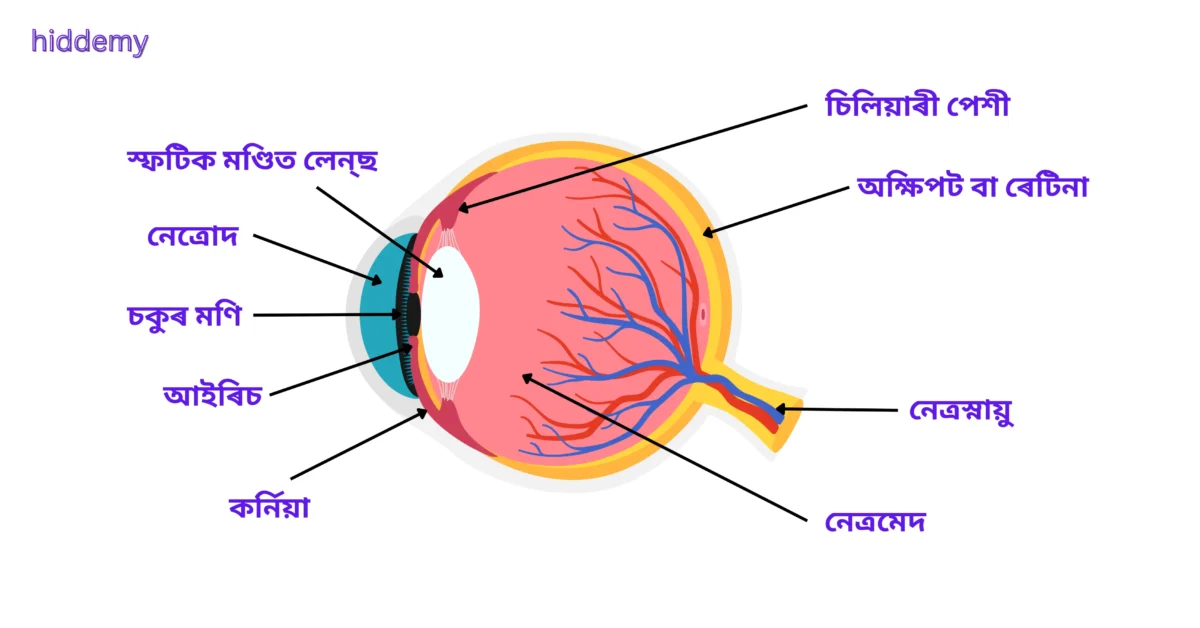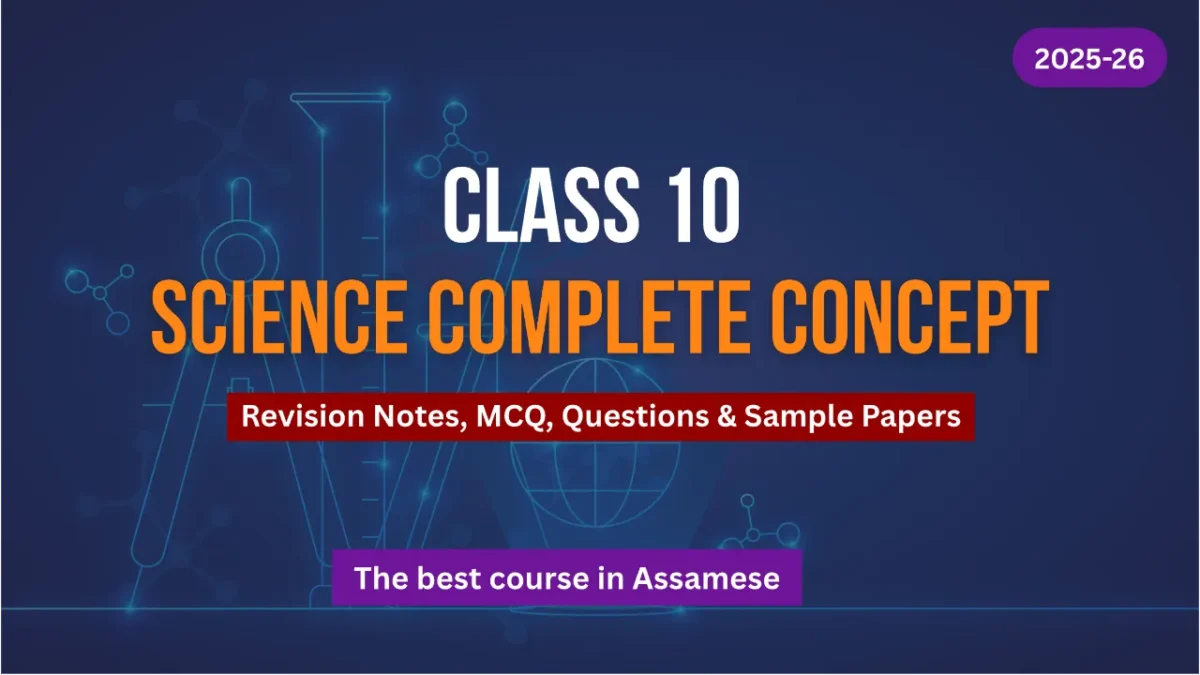SEBA Class 10 Science Chapter 11 Notes: The Human Eye and the Colourful World | মানুহৰ চকু আৰু বৰ্ণিল পৃথিৱী
SEBA Class 10 Science Chapter 11 Notes The Human Eye and the Colourful World
SEBA Class 10 Science Chapter 11 Notes The Human Eye and the Colourful World are specially prepared for HSLC 2026 students studying under SEBA. These SEBA Class 10 Science Chapter 11 Notes The Human Eye and the Colourful World clearly explain the structure of the eye, its functioning, and important vision defects like myopia, hypermetropia, and presbyopia with their corrections in Assamese medium.
You will find that SEBA Class 10 Science Chapter 11 Notes The Human Eye and the Colourful World also cover important light-related phenomena such as atmospheric refraction, scattering of light, dispersion, and rainbow formation. These SEBA Class 10 Science Chapter 11 Notes The Human Eye and the Colourful World include labelled diagrams and concept-based explanations for better understanding.
To prepare well for the exam, rely on SEBA Class 10 Science Chapter 11 Notes The Human Eye and the Colourful World. These SEBA Class 10 Science Chapter 11 Notes The Human Eye and the Colourful World simplify the concepts for Assamese medium learners. For additional revision, visit the Chapter 11 Questions & Answers page for practice materials.
SEBA Class 10 Science Chapter 11 Notes: The Human Eye and the Colourful World | মানুহৰ চকু আৰু বৰ্ণিল পৃথিৱী
✦ পৰিচয় (Introduction)
এই অধ্যায়ত আমি মানুহৰ চকুৰ গঠন, কাৰ্যপ্ৰণালী আৰু দৃষ্টিৰ ত্ৰুটিৰ প্ৰতিকাৰৰ বিষয়ে পঢ়িম। লগতে পোহৰৰ প্ৰতিসৰণ, বিচ্ছুৰণ আৰু বিক্ষেপণৰ ফলত প্ৰকৃতিত দেখা ৰামধেনু, আকাশৰ নীলা ৰং আৰু সূৰ্যোদয়-সূৰ্যাস্তৰ সময়ত সূৰ্যৰ ৰঙা ৰঙৰ কাৰণৰ বিষয়েও আলোচনা কৰিম।
✦ মানুহৰ চকু (The Human Eye)
মানুহৰ চকু আমাৰ এটা অতি গুৰুত্বপূৰ্ণ ইন্দ্ৰিয়। ই আমাক আমাৰ চাৰিওফালৰ সুন্দৰ আৰু বৰ্ণিল জগতখন দেখুৱায়।
✦ মানুহৰ চকুৰ গঠন (Structure of the Human Eye)
মানুহৰ চকু এটা কেমেৰাৰ দৰে। ইয়াৰ মুখ্য অংশসমূহ:
- কৰ্ণিয়া (Cornea): চকুৰ সন্মুখৰ স্বচ্ছ অংশ। পোহৰ সোমায় আৰু প্ৰতিসৰণ ঘটায়।
- চকুৰ মণি (Pupil): কৰ্ণিয়াৰ পিছফালে থকা সৰু ফুটা। পোহৰৰ পৰিমাণ নিয়ন্ত্ৰণ কৰে।
- চকুৰ পতা (Iris): মণিৰ চাৰিওফালে থকা ৰঙীন অংশ। মণিৰ আকাৰ নিয়ন্ত্ৰণ কৰে।
- চকুৰ লেন্স (Lens): স্বচ্ছ অংশ। পোহৰ ফ’কাছ কৰি অক্ষিপটত প্ৰতিবিম্ব গঠন কৰে।
- অক্ষিপট (Retina): পিছফালে থকা পোহৰ সংবেদী পৰ্দা। পোহৰক বৈদ্যুতিক সংকেতলৈ ৰূপান্তৰ কৰে।
- নেত্ৰ-স্নায়ু (Optic Nerve): সংকেত মগজুলৈ প্ৰেৰণ কৰে।
- চিলিয়াৰী পেশী (Ciliary Muscles): লেন্সৰ ফ’কাছ দৈৰ্ঘ্য সলনি কৰে।
- নেত্ৰমেদ (Vitreous Humour): চকুৰ লেন্স আৰু অক্ষিপটৰ মাজত থকা জেলীৰ দৰে পদাৰ্থ। ই চকুৰ আকৃতি বৰ্তাই ৰাখে।

চিত্ৰ: মানুহৰ চকুৰ গঠন
✦ মানুহৰ চকুৰ কাৰ্যপ্ৰণালী (Working of the Human Eye)
- পোহৰ কৰ্ণিয়াৰ মাজেৰে চকুত সোমায় আৰু প্ৰতিসৰণ ঘটে।
- চকুৰ মণিৰ মাজেৰে পোহৰ লেন্সলৈ যায়। চকুৰ পতাই পোহৰৰ পৰিমাণ নিয়ন্ত্ৰণ কৰে।
- লেন্সে পোহৰক ফ’কাছ কৰি অক্ষিপটত স্পষ্ট, সৎ আৰু ওলোটা প্ৰতিবিম্ব গঠন কৰে।
- অক্ষিপটৰ পোহৰ সংবেদী কোষবোৰে পোহৰক বৈদ্যুতিক সংকেতলৈ ৰূপান্তৰ কৰে।
- নেত্ৰ-স্নায়ুৰ জৰিয়তে এই সংকেত মগজুলৈ যায়। মগজুৱে সংকেত বিশ্লেষণ কৰি আমাক বস্তু দেখুৱায়।
✦ উপযোজন ক্ষমতা (Power of Accommodation)
চকুৰ লেন্সে ফ’কাছ দৈৰ্ঘ্য সলনি কৰি ওচৰৰ আৰু দূৰৰ বস্তু স্পষ্টকৈ দেখাৰ ক্ষমতাক উপযোজন ক্ষমতা বোলে।
- দূৰৰ বস্তু দেখোঁতে: চিলিয়াৰী পেশী শিথিল হয়, লেন্স ক্ষীণ হয় আৰু ফ’কাছ দৈৰ্ঘ্য বাঢ়ে। ফলত দূৰৰ বস্তু স্পষ্টকৈ দেখা যায়।
- ওচৰৰ বস্তু দেখোঁতে: চিলিয়াৰী পেশী সংকোচন হয়, লেন্সৰ বক্ৰতা বাঢ়ে আৰু ফ’কাছ দৈৰ্ঘ্য কমে। ফলত ওচৰৰ বস্তু স্পষ্টকৈ দেখা যায়।
✦ গুৰুত্বপূৰ্ণ সংজ্ঞা
স্পষ্ট দৃষ্টিৰ ন্যূনতম দূৰত্ব (Least Distance of Distinct Vision)
- চকুৰ পৰা যি ন্যূনতম দূৰত্বত বস্তু এটা স্পষ্টকৈ দেখা যায়, তাক স্পষ্ট দৃষ্টিৰ ন্যূনতম দূৰত্ব বা নিকট বিন্দু (Near Point) বোলা হয়। সুস্থ চকুৰ বাবে এই দূৰত্ব ২৫ চে.মি.।
দূৰ বিন্দু (Far Point)
- চকুৰে স্পষ্টকৈ দেখা আটাইতকৈ দূৰৰ বিন্দু। সুস্থ চকুৰ বাবে দূৰ বিন্দু অসীমত থাকে।
দৃষ্টিৰ পৰিসৰ (Range of Vision)
- সুস্থ চকুৱে ২৫ চে.মি.ৰ পৰা অসীম দূৰত্বলৈ বস্তু স্পষ্টকৈ দেখা পায়।
✦ ছানি পৰা (Cataract)
- বয়স বাঢ়িলে কেতিয়াবা চকুৰ লেন্স অস্পষ্ট হৈ যায়। এই অৱস্থাক ছানি পৰা বোলে।
- ইয়াৰ ফলত দৃষ্টিশক্তি আংশিক বা সম্পূৰ্ণৰূপে হেৰায়। অস্ত্ৰোপচাৰৰ দ্বাৰা এই সমস্যা সমাধান কৰিব পাৰি।
🎁 Coupon Code: Gem100 ব্যৱহাৰ কৰা।
Enroll in Our Class 10 Science Course!
Unlock the full SEBA Class 10 Science Chapter 11 – The Human Eye and the Colourful World experience with beautifully designed diagrams, detailed notes, and expert guidance. Perfect for HSLC 2026 preparation.

Class 10 Science Detail Notes Course FAQs
Course Details
Summary: This course is a complete package for SEBA Class 10 Science. It covers Physics, Chemistry, and Biology chapters with Assamese-medium explanations, diagrams, MCQs, previous year questions, and practice sets—all in one place for HSLC 2026.
Course Benefits
Summary: Get expert-made notes, interactive quizzes, downloadable PDFs, chapter-wise videos, and exam-focused MCQs. Designed for complete understanding and high score in Class 10 SEBA exams.
What You'll Learn
Summary: You will master chapters like The Human Eye and the Colourful World, Heredity and Evolution, Control and Coordination, Periodic Table, etc., with topic-wise videos, animations, NCERT-based questions, and bilingual (English–Assamese) support.
Duration & Format
Summary: Self-paced online course accessible anytime. Notes and videos available 24×7 with lifetime access after enrollment. Study at your own speed!
Who Should Join
Summary: Ideal for Class 10 SEBA students (Assamese Medium), especially those preparing for HSLC 2026. Also suitable for students who want visual learning, practice materials, and full revision help.
Explore More
| Chapter | Resources |
|---|---|
| Chapter 5: মৌলৰ পৰ্যাবৃত্ত শ্ৰেণীবিভাজন | |
| Chapter 7: নিয়ন্ত্ৰণ আৰু সমন্বয় | |
| Chapter 9: বংশগতি আৰু ক্ৰমবিকাশ | |
| Chapter 11: মানুহৰ চকু আৰু বৰ্ণিল পৃথিৱী | |
| Chapter 14: শক্তিৰ উৎস | |
| Additional Resources |



